Working 9 to 5 has been considered the norm for decades. And while people have always worked gigs, the advancement of technology has catalyzed the gig economy. Unlike in the past, when gigs were characteristic only for certain types of work, today, gig workers come from all walks of life.
The so-called “gig economy” is altering how people perceive work, and professionals with different skills are turning to this avenue to explore new opportunities and sources of income.
But what is the gig economy, what fueled its growth, and is it right for you? We’ll help you decide by looking at the benefits and drawbacks of the gig economy and how you can start earning money online today.
Let’s dive in.
What is the Gig Economy?
The concept of temporary work engagements, also known as “gigs,” is nothing new. However, when we talk about the gig economy today, we are talking about technology-enabled, short-term gigs in which people are hired and paid through a platform to perform tasks.
A gig economy job can be anything from driving passengers and delivering food to tutoring, short-term renting properties, and substitute teaching. The main difference between a gig and traditional work arrangements is that a gig is a temporary work engagement, and the worker is paid only for a specific job.
Gig economy definition
The gig economy is an economic system in which independent workers engage in freelance and side-hustle work, which is enabled by technology (usually a software platform) that serves customers.
If we drill down this definition, we can see that the gig economy is a system comprising three main components: 1) independent workers who get paid by task or project, 2) customers who need the service, and 3) the platform that connects both.
The History of the Gig Economy
The term “gig” was (and still is) used by musicians. Jazz musicians started using this term at the beginning of the 20th century to refer to a live performance job. Since then, people have used the term “gig” for different short-term jobs.
Gig jobs were later fueled by the emergence of temporary agencies. In 1946, Russell Kelly Office Service connected women, who had kept America’s economy moving forward during World War II, with office work in Detroit. Two years later, Manpower, inc. was founded to provide temporary staff for companies in need.
The early days of the gig economy on the internet started with companies such as Craigslist (1995) and freelance platforms Elance (1998) and oDesk (2003), which later rebranded into Upwork. All these short-time jobs and projects got under the umbrella term “gig economy,” which former New Yorker editor Tina Brown coined in 2009.
The rise of mobile apps marked the next stage of the gig economy. Companies such as AirBnB, TaskRabbit, Uber, and Lyft became the medium through which gig workers connect and get paid by customers. These apps make it easy for workers to find temporary jobs (gigs), which can be anything from transportation to fixing leaky faucets.
According to McKinsey, the need to support basic family needs, autonomy and flexibility, and additional income are among the top reasons people engage in independent work.
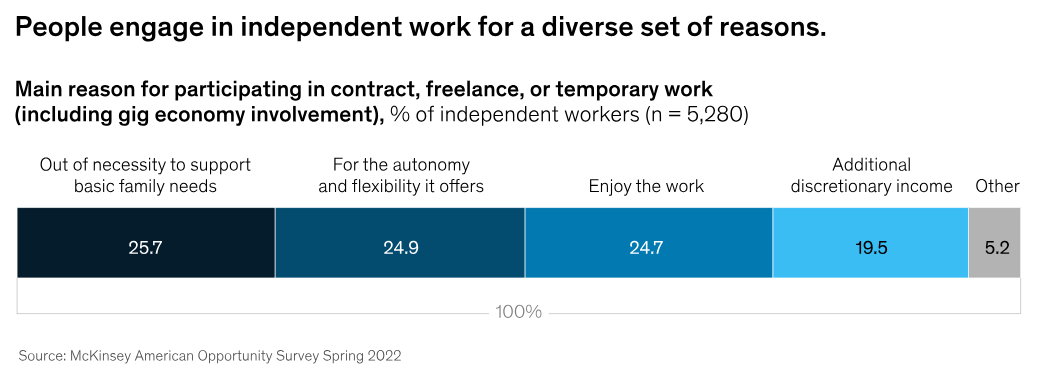
Moreover, technology has made it easier than ever to work independently. Digital platforms have grown significantly in recent years, empowering a larger pool of people to connect with customers for short-term gigs.
How is the Gig Economy Growing?
According to research from the University of Chicago, the platform gig economy grew by 150%, or 3 million people, between 2019-2021. Data from Statista shows that the gross volume the United States gig economy generated grew from $204 billion (USD) in 2018 to $455 billion by 2023.
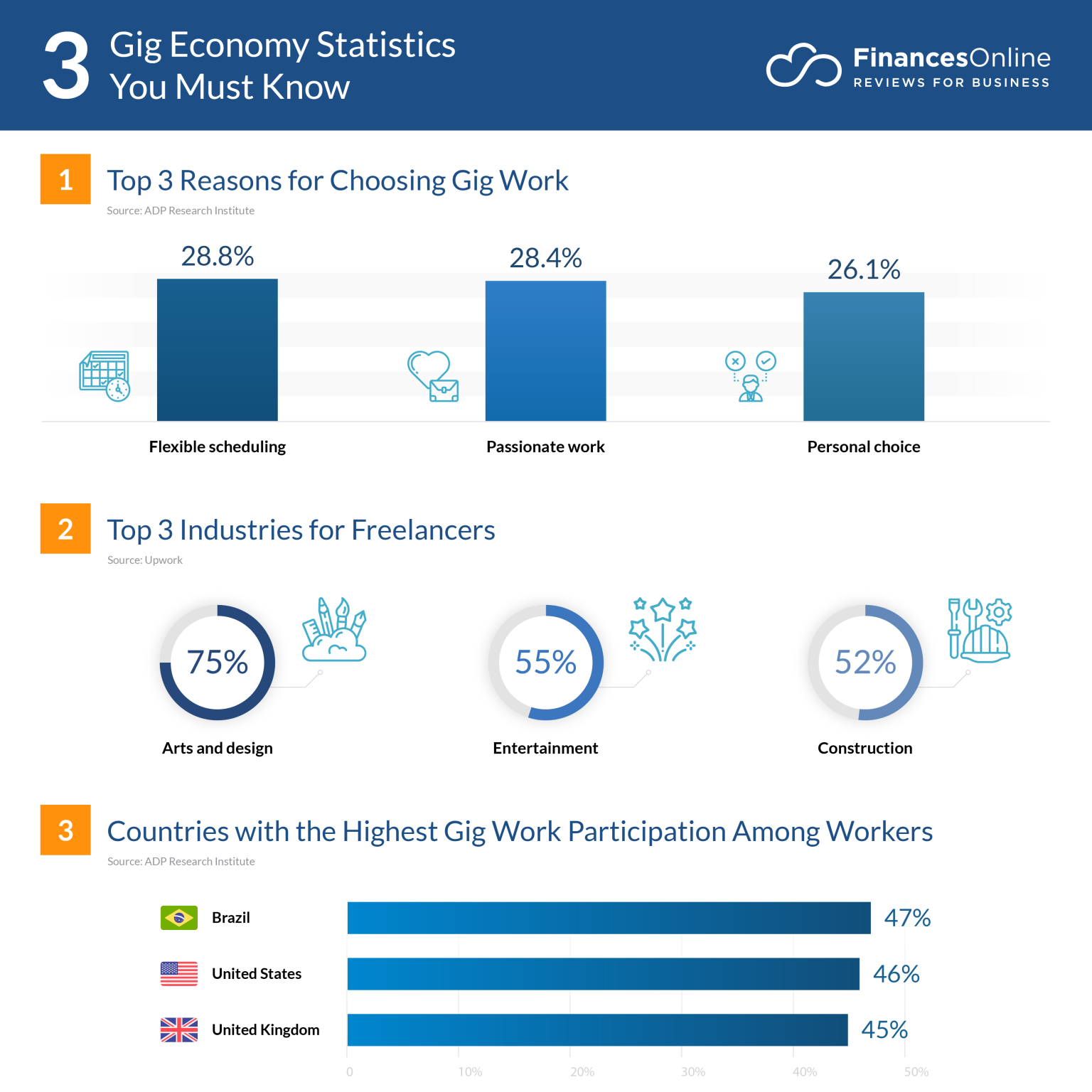
The question is: what fueled the gig economy growth?
If we scratch beneath the surface, we can see that the COVID-19 pandemic strongly impacted short-term jobs. To stay buoyant during the pandemic, many companies shifted to independent workers. Moreover, the layoffs during the pandemic forced a more significant number of workers to engage in short-term gigs, whether as a replacement for their full-time employment or as an additional source of income.
COVID-19 spurred another pattern—during 2021 and 2022, a record number of employees voluntarily quit their jobs. This phenomenon, known as The Great Resignation, further propelled the gig economy’s growth.
In 2022, more than 50 million Americans participated in the Great Resignation. After peaking between November 2021 and April 2022, when almost 4.5 million people quit on average per month, the movement started to lose steam throughout 2023.
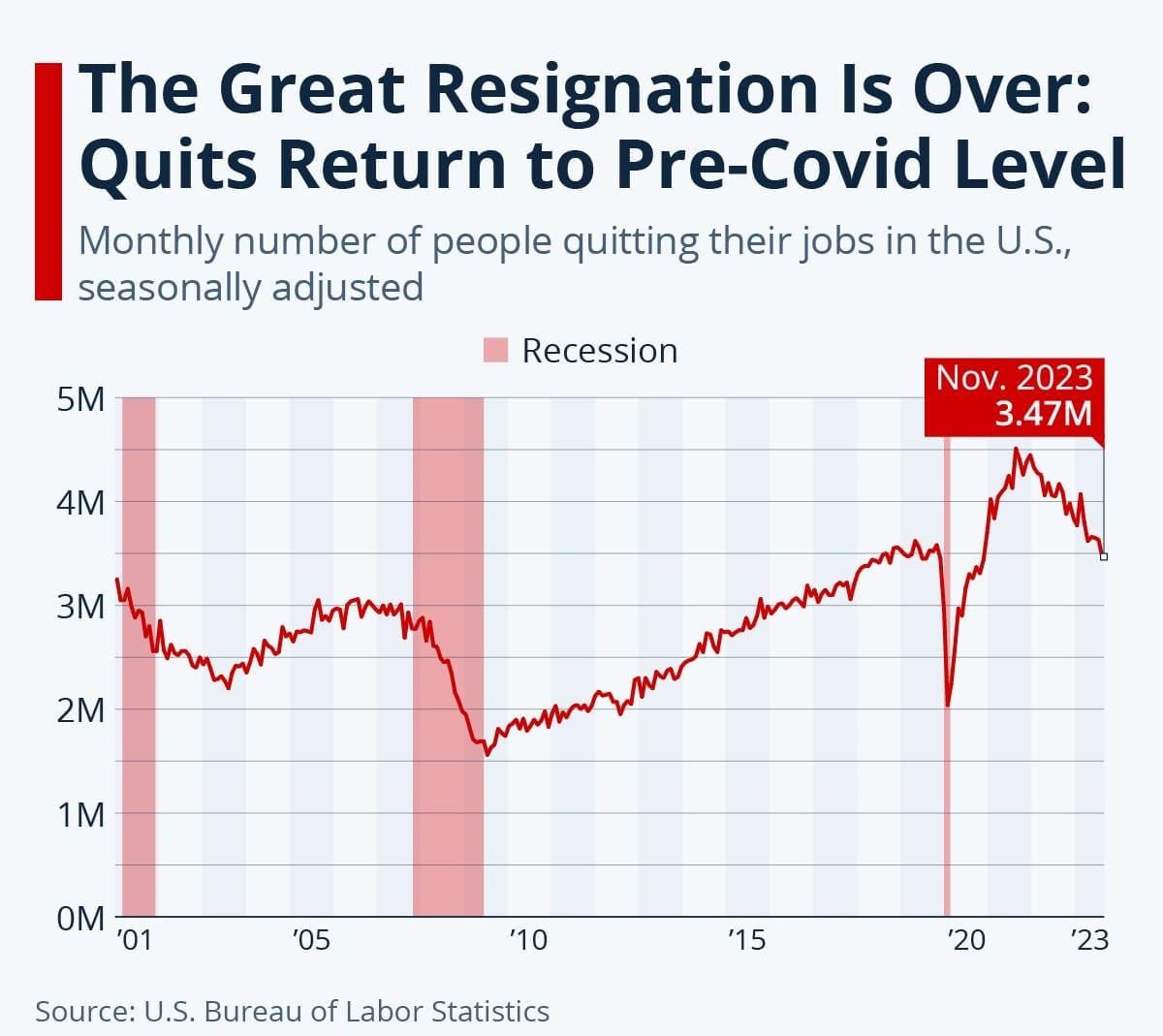
However, the pandemic was the straw that broke the camel's back. The Great Resignation was a result of a cumulation of long-term trends and factors, which the Harvard Business Review defined as the five Rs—retirement, relocation, reconsideration, reshuffling, and reluctance. People wanted more flexibility and better work-life balance, contributing to more short-term gigs.
Now you’re probably wondering: What is the aftermath of the pandemic and the Great Resignation, and how is the gig economy growing? Well, it looks like the gig economy is on an upward trajectory. It’s projected that 86.5 million people, or over 50% of the US workforce will participate in the gig economy by 2027.
According to Bank of America, the number of customers who received income from gig platforms through direct deposits or debit cards was above 3.8% in March 2024, surpassing the previous peak in early 2022. The increase in gig employment has been driven primarily by gains in ridesharing, as traffic volumes approach pre-pandemic levels.
It also appears gig workers are increasingly going 'all in' on it, with the share of gig workers who earn income every month of the year increasing every year since 2021.
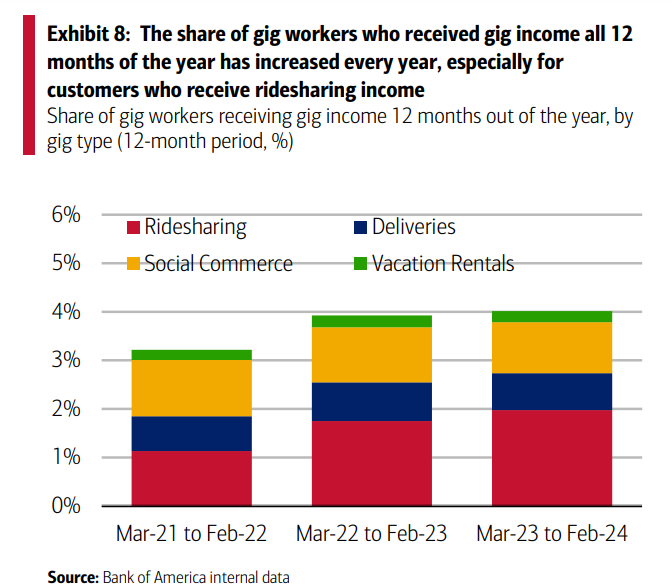
15 Examples of Gig Economy Jobs
People are increasingly gravitating toward the nontraditional sector of employment. While in the past, gigs were limited to task-based jobs performed through the mediation of temporary staffing agencies, today, advancements in technology have opened up great opportunities for people looking for gig economy jobs. Let’s look at some of the most popular jobs.
1. Freelance writer—The freedom and flexibility of earning money writing online have made freelance writing one of the most popular gig economy jobs. Freelance writers craft articles, blog posts, and marketing copy for a wide array of clients. The average pay is $53,318 per year, and it can go up to $130,447.
2. Online coaching—Online coaching enables experts to offer personalized guidance and training in areas such as fitness, business, or personal development through virtual platforms. Coaching requires tailored advice and support and maintaining a high level of client engagement. The average annual salary for an online coach is $47,000 - $86,000.
3. Graphic designer—One of the most creative gig economy jobs is graphic design. This job involves creating visual content such as logos, marketing materials, and digital artwork for various clients. Unlike in-house graphic designers who follow strict branding guidelines, freelance graphic designers work with multiple clients, making the work more exciting and creative. The average freelance graphic designer pay range is $50,000 - $80,000 per year.
4. Web designer—Another gig economy job is web design, which combines technical expertise with creative design to produce user-friendly and visually appealing sites. Web designers must stay current with the latest technologies to remain relevant and create engaging website experiences. The estimated total pay range for a Web Designer at Freelancer is $57,000 - $99,000 per year.
5. Online course creator—Creating online courses is a growing gig economy job that involves developing and selling educational content on different topics. This role requires designing engaging video lessons, interactive materials, and assessments for learners worldwide. Online course builders can make between $64,000 - $120,000 per year.
6. Social media manager—Managing social media accounts covers everything from content planning and creation to real-time interaction and analytics. The social media manager job offers flexibility and the ability to work remotely. The average pay range for this job is $45,000 - $82,000 per year.
7. Virtual assistant—Another popular gig economy job is virtual assistant. The onset of remote work catalyzed the demand for virtual assistants. Tasks typically include managing schedules, handling correspondence, and coordinating various activities. The average pay for virtual assistants is $79,279, which can go up to $127,160.
8. Transcription services—Transcription services involve converting audio recordings into written text, requiring keen attention to detail and accuracy. This gig economy role is often performed remotely, allowing transcriptionists to work from anywhere and choose their own hours. The average pay range for this job is $37,000 - $56,000 per year.
9. Rideshare driver—Rideshare driving is a popular gig economy job where individuals transport passengers to various destinations using their personal vehicles. Bank of America data suggests that ridesharing work is popular with Millennials and Gen X – responsible for over a third of gig employment for both generations. According to the same source, ridesharing offers the second-highest average monthly income of the four main types of gig work (Vacation rentals, ridesharing, deliveries, and social commerce). The average pay range for rideshare drivers is $45,000 - $79,000 per year.
10. Food delivery driver—Food delivery involves transporting meals from restaurants to customers' homes, a job characterized by its fast-paced and flexible nature. The convenience of ordering meals online has led to a significant increase in consumers using online food delivery services. Moreover, the rise of third-party delivery services such as Uber Eats and DoorDash accelerated the growth of food delivery driver jobs. Food delivery drivers can make $40,000 - $70,000 per year.
11. Nanny or caregiver—Providing personalized care and support to children or adults is another popular gig economy job. This role involves creating a safe and engaging environment, managing daily routines, and addressing individual needs. The average salary for a babysitter/nanny is $50,686 per year in the United States, and it can go as high as $78,386.
12. Petsitter or dog walker—Petsitting and dog walking are sought-after gig economy roles for animal lovers who care for pets in their owners' absence. These jobs involve feeding, exercising, and attending to the needs of pets, offering flexibility and the joy of working with animals. The average pay range for this job is $47,000 - $72,000 annually.
13. Task-based gig worker—Task-based gig work encompasses a wide range of short-term jobs, such as assembling furniture or running errands, that individuals take on based on their skills and availability. The emergence of platforms such as TaskRabbit and Amazon Mechanical Turk fueled the popularity of these jobs. The average pay range depends on the type of task. For example, the average pay range for furniture assembly is $40,000 - $58,000 per year.
14. Handyman or house cleaner—Handyman and house cleaning services involve performing various maintenance and cleaning tasks for homeowners. These roles require a blend of practical skills and attention to detail as workers tackle everything from minor repairs to thorough cleanings. The average salary for a house cleaner in the United States is $46,093 per year, and it can go as high as $70,504.
15. Short-term rentals host—Hosting short-term rentals involves preparing and managing a property for guests seeking temporary accommodations. This gig economy job includes handling bookings, ensuring the property is clean and welcoming, and addressing guest needs. The average pay range is $45,668, and it can go to $71,644.
Is the Gig Economy Right for You?
Now, it’s time to put everything into perspective. Looking at all these statistics and numbers, you’re probably wondering if the gig economy is the right choice for you. Let’s go through the benefits and drawbacks the gig economy offers to employees and companies.
Gig economy benefits for employees
- Flexibility—If you’re looking for flexibility, you’re in the right place. According to Statista, 69% of male respondents in the United States said they chose to work independently because they love being their own boss, compared to 55% of female respondents who said the same.
- Job satisfaction—Another benefit of taking part in the gig economy is doing what you love. Data shows that 77% of people working in the gig economy reported being very satisfied with their job.
- Learning new skills—If you’re open to learning new skills, gigs can be the best way to do it. According to Statista, 26% of respondents reported that learning new skills was a surprising aspect of working in the gig economy.
Gig economy drawbacks for employees
- Lack of job security—One of the biggest drawbacks for individuals is the lack of job security, which puts them under considerable pressure due to economic fluctuations.
- Inconsistent income—Independent workers lack stability and security and are always on the lookout for new opportunities. Data shows that 62% of respondents in the United States who participated in flexible work said their emergency savings would not last six months.
- Unequal employee benefits—Another significant drawback of gig economy jobs is the lack of employment benefits and protections, such as minimum wage and overtime entitlements.
Gig economy benefits for employers
- Cost savings—Hiring short-term gig workers is more cost-effective for companies, as they do not have to cover the benefits or onboarding costs linked to a full-time employee.
- Bigger talent pool—The gig economy opened the border and gave companies access to a large, flexible workforce qualified for their needed positions.
- Scalability—One of the biggest challenges of scaling a business is hiring more people. Companies can scale their businesses while managing costs thanks to the gig economy. What’s more, businesses have additional flexibility to change decisions and hiring priorities based on changing business needs on their path to growth.
Gig economy drawbacks for employers
- Lack of engagement and commitment—Cultivating engagement, commitment, and corporate culture is more challenging when working with gig workers.
- Lack of availability—Gig economy workers are handling multiple projects simultaneously, which means they might not be available if you don’t have a long-term agreement with them.
- No long-term commitment—Gig economy jobs are short-term and project-by-project. As a result, it’s hard to make long-term projections and plans.
How Whop Helps Creators Join the Gig Economy and Create Sustainable Income Online
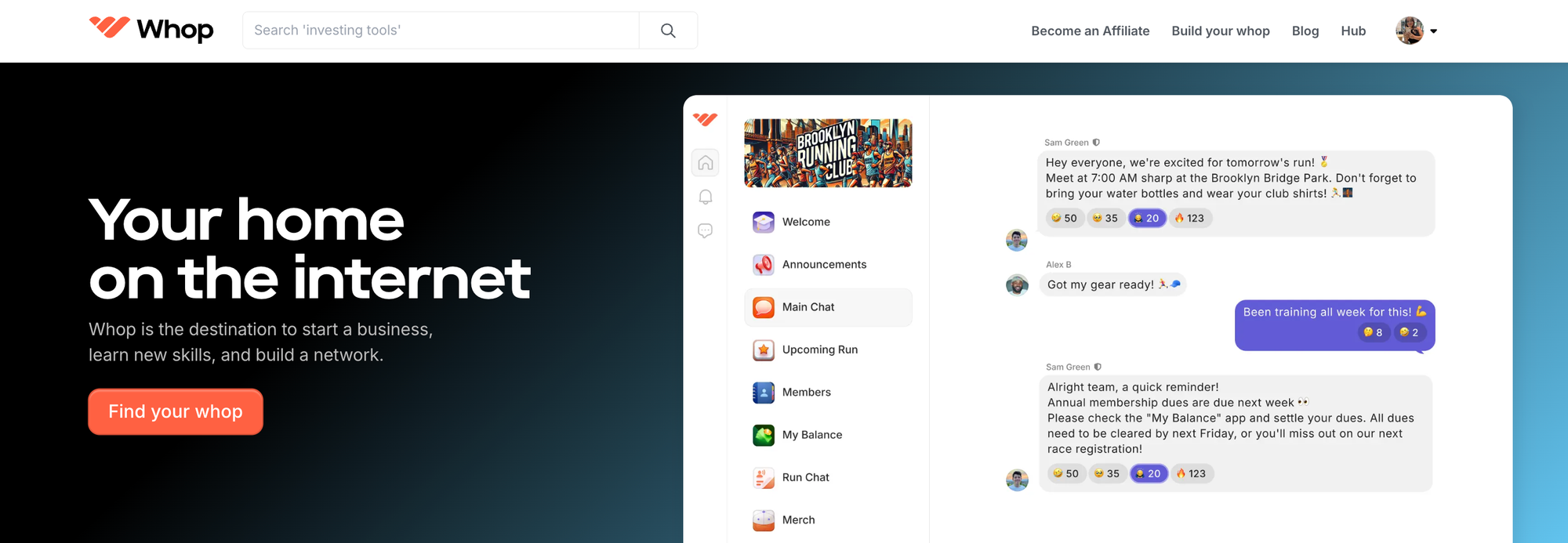
Creators are uniquely positioned to monetize their skills and expertise as they are at the intersection of both the creator economy and the gig economy. Being hyper-connected in the digital world has opened new ways to make money online by picking up a “gig.”
From selling digital products and online courses to online coaching and freelance writing, creators can capitalize on the gig economy and create a new revenue stream to supplement their income.
If you’re looking for ways to participate in the gig economy, check out Whop. Whop is a one-stop solution that provides digital creators with the best platform to sell their digital products and services. Whop offers a different selling experience and product discovery engine, and becoming part of the Whop marketplace puts your products in front of over 1 million unique visitors, who browse, discover, and buy digital products every month.
The no-code builder lets you design your own whop and start selling almost instantly - whether you want to sell access to an online community, ebooks, online courses, masterminds, coaching, webinars, digital downloads, and so much more - you can do it with Whop. Simply create your whop, price your products, and start selling. It's as easy as that. Whop sellers also get access to promotion and CRM tools and a detailed analytics dashboard.
Ready to make your first dollar on the internet? Join the gig economy today.
FAQs
Do gig economy workers pay tax?
Gig economy workers must file a tax return if they have net earnings from self-employment of $400 or more from gig work, even if it's a side job, part-time or temporary, according to the IRS. If you do gig work as an independent contractor, you may have to pay estimated taxes.
Do you get health insurance for gig jobs?
Gig workers are considered independent contractors, and as such, they must secure their own health coverage. Even though this is considered one of the main drawbacks of gig economy jobs, there are affordable options for gig workers to choose from to maintain medical coverage.
How much money can you make with gig economy work?
The amount of money you can make with gig economy work varies depending on the type of job, skill level, and frequency of engagement. For example, a freelance writer can earn up to $130,000 per year, online course creators can make between $64,000 - $120,000 per year, and rideshare drivers can earn between $45,000 - $79,000 per year.




